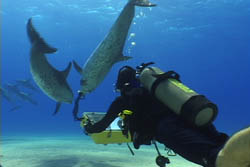Avalanche of New Diseases Hits Marine Mammals
Quebec City, Canada, October 14, 2009
By Hardy Jones
Dolphins and other marine mammals are often described as sentinels of the health of the seas. They are long-lived, coastal dwelling, top-of-the-food-chain predators, sharing those characteristics with humans. The news from these sentinels is that the oceans are contaminated to a degree that seriously threatens the health of not only marine mammals but humans as well.
At the previous meeting of the Society of Marine Mammalogy in Cape Town in 2007, a major theme was that dangerous levels of toxins have been detected in many species of marine mammal in locations around the world and that this is impacting their immune systems.
At the current meeting in Quebec the chickens have come home to roost. Actually they’ve been coming home for a log time but now scientists have caught up to it. Until we turned the oceans into a chemical soup a bacteria, virus or fungus, ubiquitous or commonly found in the environment, was taken care of by a healthy dolphin, seal or manatee immune system. Those immune systems are now being assaulted by high levels of contaminants building up in marine mammals globally.
The chemical industry has maintained that dilution of chemical waste was the solution to the problem. What they did not count on is the biomagnification of toxic chemicals by the marine food chain causing marine mammals to ingest and store dangerous levels of organic pollutants.
The following is a partial list of papers presented at the conference describing diseases emerging among marine mammals. Many of them have heretofore been unknown or rarely found among marine mammals. The sheer volume and variety of these diseases is highly alarming.
New diseases being found in dolphins: papilloma, brucellosis, morbillivirus, toxoplasmosis, leptospirosis, botulism, cholera, salmonella.
Toxoplasmosis in polar bears in Svalbard, Norway. Possibly due to warming waters and more diverse array of migratory birds arriving in the island.
Opportunistic Antibiotic Resistant Organisms Cultured from Atlantic Bottlenose Dolphins Inhabiting Estuarine Waters of Charleston, SC and Indian River Lagoon (Florida). Paper by Bossart et al.
Bossart et al have found high percentage of dolphins along the southeastern coast of the United States to have epidermal lesions. Same researchers have found lobomycosis in bottlenose dolphins in same area along with orogenital papilloma.
Unusual mortalities of marine mammals in the St. Lawrence Estuary associated with saxitoxin-producing red tide.
Giardia and Cryptosporidium found in North Atlantic and Southern Right Whales.
Streptococci in marine mammals stranded around the British Isles.
There has been first confirmation of Phocine Distemper Virus (PDV) in sea otters in Alaska. There has been a huge decline in the Alaska sea otter population over recent years.
Tracy Goldstein.
Verminous pneumonia found in Saint Lawrence Estuary (SLE) Belugas. This derives from lungworm. One hundred percent of the adult and juvenile populations have this affliction.
Geuix et al.
PBDE concentrations in marine biota and people from North America are the highest in the world and are increasing. PBDE concentrations in marine biota and people from North America are the highest in the world and are increasing. Susan Shaw et al
Distemper has caused epizootics in Lake Baikal, the Caspian Sea and Northern Europe.
Organochlorine pesticides found in Galapagos sea lions.
There are many more and the whole problem is compounded by warming of the climate. Organic pollutants bound in ice are released when the ice melts. As waters warm prey species may decline or disappear. In many diverse locations marine mammals are reported to have thinner layers of blubber meaning that pollutants stored in fat have been released into the blood and organs of the animal.
President Obama has recently called for a massive strengthening of the laws governing production, distribution and disposal of toxic chemicals. The chemical companies will fight it tooth and nail but far stricter standards must be applied - not just to save marine mammals but humans as well.
Subscribe to:
Post Comments (Atom)


No comments:
Post a Comment